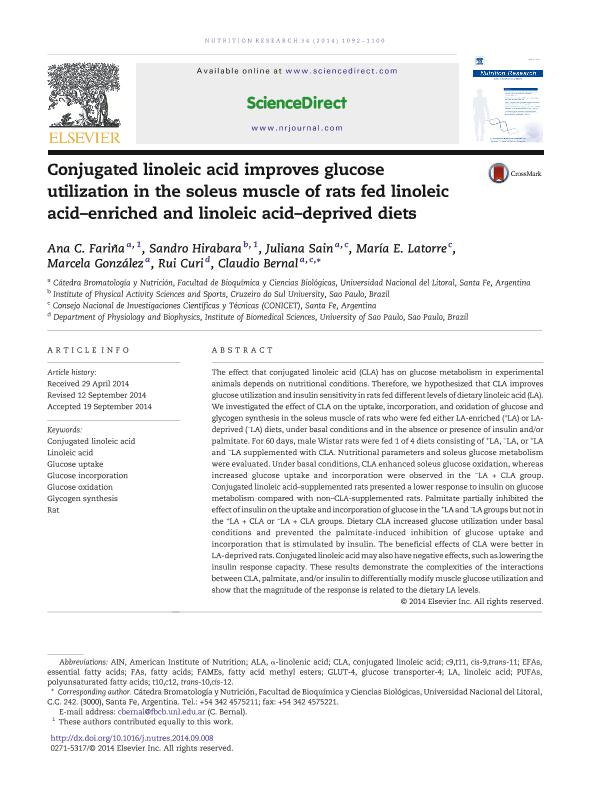Mostrar el registro sencillo del ítem
dc.contributor.author
Fariña, Ana Clara

dc.contributor.author
Hirabara, Sandro
dc.contributor.author
Sain, Juliana

dc.contributor.author
Latorre, Maria Emilia

dc.contributor.author
González, Marcela Hebe

dc.contributor.author
Curi, Rui
dc.contributor.author
Bernal, Claudio Adrian

dc.date.available
2017-05-04T18:31:10Z
dc.date.issued
2014-12
dc.identifier.citation
Fariña, Ana Clara; Hirabara, Sandro; Sain, Juliana; Latorre, Maria Emilia; González, Marcela Hebe; et al.; Conjugated linoleic acid improves glucose utilization in the soleus muscle of rats fed linoleic acid–enriched and linoleic acid–deprived diets; Elsevier Inc; Nutrition Research; 34; 12; 12-2014; 1092-1100
dc.identifier.issn
0271-5317
dc.identifier.uri
http://hdl.handle.net/11336/15989
dc.description.abstract
The effect that conjugated linoleic acid (CLA) has on glucose metabolism in experimental animals depends on nutritional conditions. Therefore, we hypothesized that CLA improves glucose utilization and insulin sensitivity in rats fed different levels of dietary linoleic acid (LA). We investigated the effect of CLA on the uptake, incorporation, and oxidation of glucose and glycogen synthesis in the soleus muscle of rats who were fed either LA-enriched (+LA) or LA-deprived (−LA) diets, under basal conditions and in the absence or presence of insulin and/or palmitate. For 60 days, male Wistar rats were fed 1 of 4 diets consisting of +LA, −LA, or +LA and −LA supplemented with CLA. Nutritional parameters and soleus glucose metabolism were evaluated. Under basal conditions, CLA enhanced soleus glucose oxidation, whereas increased glucose uptake and incorporation were observed in the −LA + CLA group. Conjugated linoleic acid–supplemented rats presented a lower response to insulin on glucose metabolism compared with non–CLA-supplemented rats. Palmitate partially inhibited the effect of insulin on the uptake and incorporation of glucose in the +LA and –LA groups but not in the +LA + CLA or −LA + CLA groups. Dietary CLA increased glucose utilization under basal conditions and prevented the palmitate-induced inhibition of glucose uptake and incorporation that is stimulated by insulin. The beneficial effects of CLA were better in LA-deprived rats. Conjugated linoleic acid may also have negative effects, such as lowering the insulin response capacity. These results demonstrate the complexities of the interactions between CLA, palmitate, and/or insulin to differentially modify muscle glucose utilization and show that the magnitude of the response is related to the dietary LA levels.
dc.format
application/pdf
dc.language.iso
eng
dc.publisher
Elsevier Inc

dc.rights
info:eu-repo/semantics/openAccess
dc.rights.uri
https://creativecommons.org/licenses/by-nc-nd/2.5/ar/
dc.subject
Conjugated Linoleic Acid
dc.subject
Linoleic Acid
dc.subject
Glucose Uptake
dc.subject
Glucose Incorporation
dc.subject
Glucose Oxidation
dc.subject
Glucogen Synthesis
dc.subject
Rat
dc.subject.classification
Nutrición, Dietética

dc.subject.classification
Ciencias de la Salud

dc.subject.classification
CIENCIAS MÉDICAS Y DE LA SALUD

dc.title
Conjugated linoleic acid improves glucose utilization in the soleus muscle of rats fed linoleic acid–enriched and linoleic acid–deprived diets
dc.type
info:eu-repo/semantics/article
dc.type
info:ar-repo/semantics/artículo
dc.type
info:eu-repo/semantics/publishedVersion
dc.date.updated
2017-04-17T19:27:02Z
dc.journal.volume
34
dc.journal.number
12
dc.journal.pagination
1092-1100
dc.journal.pais
Países Bajos

dc.journal.ciudad
Amsterdam
dc.description.fil
Fil: Fariña, Ana Clara. Universidad Nacional del Litoral. Facultad de Bioquímica y Ciencias Biológicas. Departamento de Ciencias Biológicas. Cátedra de Bromatología y Nutrición; Argentina. Consejo Nacional de Investigaciones Científicas y Técnicas; Argentina
dc.description.fil
Fil: Hirabara, Sandro. Cruzeiro do Sul University; Brasil
dc.description.fil
Fil: Sain, Juliana. Universidad Nacional del Litoral. Facultad de Bioquímica y Ciencias Biológicas. Departamento de Ciencias Biológicas. Cátedra de Bromatología y Nutrición; Argentina. Consejo Nacional de Investigaciones Científicas y Técnicas; Argentina
dc.description.fil
Fil: Latorre, Maria Emilia. Consejo Nacional de Investigaciones Científicas y Técnicas; Argentina
dc.description.fil
Fil: González, Marcela Hebe. Universidad Nacional del Litoral. Facultad de Bioquímica y Ciencias Biológicas. Departamento de Ciencias Biológicas. Cátedra de Bromatología y Nutrición; Argentina. Consejo Nacional de Investigaciones Científicas y Técnicas; Argentina
dc.description.fil
Fil: Curi, Rui. Universidade de Sao Paulo; Brasil
dc.description.fil
Fil: Bernal, Claudio Adrian. Universidad Nacional del Litoral. Facultad de Bioquímica y Ciencias Biológicas. Departamento de Ciencias Biológicas. Cátedra de Bromatología y Nutrición; Argentina. Consejo Nacional de Investigaciones Científicas y Técnicas; Argentina
dc.journal.title
Nutrition Research

dc.relation.alternativeid
info:eu-repo/semantics/altIdentifier/doi/http://dx.doi.org/10.1016/j.nutres.2014.09.008
dc.relation.alternativeid
info:eu-repo/semantics/altIdentifier/url/http://www.sciencedirect.com/science/article/pii/S0271531714001936
Archivos asociados
